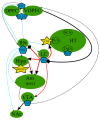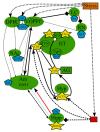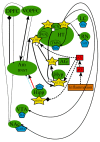Major Depression: One Brain, One Disease, One Set of Intertwined Processes
- PMID: 34064233
- PMCID: PMC8224372
- DOI: 10.3390/cells10061283
Major Depression: One Brain, One Disease, One Set of Intertwined Processes
Abstract
Major depressive disorder (MDD) is a heterogeneous disease affecting one out of five individuals and is the leading cause of disability worldwide. Presently, MDD is considered a multifactorial disease with various causes such as genetic susceptibility, stress, and other pathological processes. Multiple studies allowed the formulation of several theories attempting to describe the development of MDD. However, none of these hypotheses are comprehensive because none of them can explain all cases, mechanisms, and symptoms of MDD. Nevertheless, all of these theories share some common pathways, which lead us to believe that these hypotheses depict several pieces of the same big puzzle. Therefore, in this review, we provide a brief description of these theories and their strengths and weaknesses in an attempt to highlight the common mechanisms and relationships of all major theories of depression and combine them together to present the current overall picture. The analysis of all hypotheses suggests that there is interdependence between all the brain structures and various substances involved in the pathogenesis of MDD, which could be not entirely universal, but can affect all of the brain regions, to one degree or another, depending on the triggering factor, which, in turn, could explain the different subtypes of MDD.
Keywords: common mechanisms; etiology; major depressive disorder; pathogenesis; theories of depression.
Conflict of interest statement
The authors declare no conflict of interest.
Figures






References
Publication types
MeSH terms
Grants and funding
LinkOut - more resources
Full Text Sources

